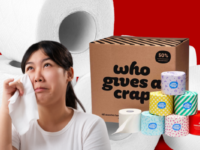More people than ever are discovering products and transacting online, but in a crowded retail landscape, brands that adopt a direct-to-consumer approach need to nail every aspect of the shopping journey to reach and retain customers.
In an Adobe-sponsored FMCG Masterclass, Tim Baxter, head of growth at eco-friendly toilet paper brand Who Gives A Crap, and Sian Murray, co-founder and creative director at zero-waste cleaning products brand Pleasant State, spoke with Dean Blake, print and features editor at Inside FMCG, about how to nail the Direct To Consumer (DTC) experience.
The overriding advice from the pair, for retailers who want to broaden their business in the Direct-to-consumer channel? Know your customers and create a clear brand and messaging strategy that resonates with them. Get personal and be authentic, talk to the individual.
“If you’re moving into DTC, make sure you have a strong brand persona and then really focus on creating content that adds value to your customers’ lives – something that is different from what anyone else is doing – and be quirky, authentic and genuine with it,” said Murray.
“Your customers will really respond and enjoy that kind of genuine emotional engagement from you. And that’s what really drives their purchasing behaviour on these platforms.”
Baxter agreed, adding that Who Gives A Crap treats every single touch point with its customers – customer service, the transaction, and emails – as marketing opportunities.
“The majority of businesses don’t do a very good job of it. You can find really interesting ways to talk to the customer, where they’re not expecting it and deliver a little surprise, or a little bit of an emotional connection.”
During the masterclass – which you can view in full here – Baxter and Murray discuss what it takes to establish a successful DTC brand, how to build and engage with audiences, how to compete with legacy brands on a budget – and how to discover untapped opportunities for growth.
Pleasant State launched at the beginning of the pandemic and Murray said the intention was to be the first mover in its category – just-add-water cleaning solutions didn’t exist in Australia then. Launching on a crowdfunding platform helped build a consumer base six months before the company started shipping its first products
“DTC is cheap and scalable and allowed us to be reactive and respond quickly,” explained Murray. “We have a novel product so there was a need to educate consumers before moving into retail.”
Being brand-led and design-focused, the founders knew the product and concept would resonate well on socials and the overarching commitment was to talk directly to consumers.
Baxter said Who Gives A Crap’s journey to becoming a DTC brand began almost by accident. The company launched in Coles supermarkets about 11 years ago, but having promised consumers it would donate 50 per cent of its profits to charity, it couldn’t stand the pressure on its margins from selling through a major supermarket chain and withdrew.
“So we were left with the decision of what do we do now? It was very early on in the business and the idea came up of ‘Let’s sell toilet paper on the internet’.” Naysayers at the time said it would never work, but a decade on, the company is thriving and Who Gives A Crap has become a household name in Australia.
According to Baxter, 80 per cent of consumers already have established habits when it comes to choosing and buying toilet paper, so the company focused on the remaining 20 per cent, recognising it needed to engage those people in a different way to the brands that were talking to the 80 per cent.
“We identified early on that the emotional aspect of our business and the social impact part were both really big drivers and if we could find the people who had that mindset already, and were making [social impact] purchases, then we could kind of jump onto that customer journey.”
The company does not use focus groups, preferring instead to put something out into the market – whether it’s an ad or a product idea – “and see where people put their money”.
It quickly became obvious to the team that word of mouth – not only the cheapest type of marketing but the best marketing – would be a big driver of customer uptake. Early on the company developed packaging and branding that encouraged discussion among friends at the dinner table or at the pub and led to people giving a roll away to mates
“So for us, it was about finding those little emotional hotspots, when people really came to share something with someone else.”
Pleasant State adopted a similar approach, from day one attempting to differentiate itself from other cleaning brands, and “change our customer’s relationship with cleaning,” explained Murray. “We wanted to make it enjoyable, something that wasn’t a necessary evil hidden under the kitchen sink.”
Using word of mouth, buoyed by its crowdfunding campaign, Pleasant State had 1500 consumers pre-ordering its products by the time it launched.
“We are really, really focused on the customer experience. Responding to and being really proactive with our customers is really important and just listening to feedback is huge as well, particularly in the early days, and particularly when you’re making a really novel product. If they have something that they’re not happy with, or they have feedback, or they have ideas, really listen to them and involve them in every step of the journey.”
Both Murray and Baxter talked about it being critical that a DTC brand’s website is engaging and an enjoyable customer experience given that sites are the most prominent face of the business to the customer, and they discussed the important role influencers can play in building brand awareness. So, too, once a sale has been made, planning an efficient, reliable third-party logistics and warehousing solution is key to maintaining customer satisfaction.
Both are bullish about opportunities in the DTC channel, with Murray stressing one of the greatest opportunities it presents is how quickly companies can move, dealing directly with customers rather than working through retailers or wholesalers in the middle. Big brands, he said, don’t have the flexibility of startups to launch a brand without even having a product.
“We knew we had this opportunity to really change behaviour quickly. For us, the ability to move faster and smarter and create a movement … and to be really reactive as well. When we started Pleasant State, we were really focused on sustainability – on solving the plastic issue. But quickly, other people entered the market into our space. And they are solving the plastic issue, too. But there’s still a bunch of things Pleasant State does that they don’t. For example, we use really high-quality plant-based ingredients. So there’s been a number of times where we’ve just pivoted our messaging a little bit and what we’re focusing on as other brands or other products entered our space. That’s something that we can do that others can’t.
“Now we’re in this space where we are becoming about more than just cleaning, and we’re doing more than just reducing plastics and health and toxins in homes – we are actually changing our customers’ behaviour with cleaning, like trying to make it more enjoyable, making it a mindful ritual, almost an act of self-care.”
Baxter concurred: “When I started out we were in effect going up against Procter and Gamble, one of the biggest companies in the world. And so it was like David and Goliath where we were small fry compared to a Fortune 500 company. Being close to the customer gives us a humongous competitive advantage against most big companies, who if they try, do it in a really watered-down way.”
Enjoy the full masterclass recording, enabled by Adobe, on this link.











